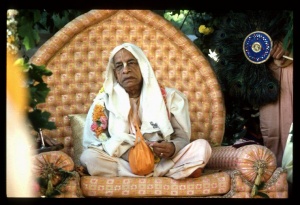CC Madhya 24.254 (1975): Difference between revisions
(Vanibot #0027: CCMirror - Mirror CC's 1996 edition to form a basis for 1975) |
(Vanibot #0020: VersionCompareLinker - added a link to the Version Compare feature) |
||
| Line 2: | Line 2: | ||
<div style="float:left">'''[[Sri Caitanya-caritamrta (1975)|Śrī Caitanya-caritāmṛta (1975)]] - [[CC Madhya (1975)|Madhya-līlā]] - [[CC Madhya 24 (1975)|Chapter 24: The Sixty-One Explanations of the Atmārāma Verse]]'''</div> | <div style="float:left">'''[[Sri Caitanya-caritamrta (1975)|Śrī Caitanya-caritāmṛta (1975)]] - [[CC Madhya (1975)|Madhya-līlā]] - [[CC Madhya 24 (1975)|Chapter 24: The Sixty-One Explanations of the Atmārāma Verse]]'''</div> | ||
<div style="float:right">[[File:Go-previous.png|link=CC Madhya 24.253 (1975)|Madhya-līlā 24.253]] '''[[CC Madhya 24.253 (1975)|Madhya-līlā 24.253]] - [[CC Madhya 24.255 (1975)|Madhya-līlā 24.255]]''' [[File:Go-next.png|link=CC Madhya 24.255 (1975)|Madhya-līlā 24.255]]</div> | <div style="float:right">[[File:Go-previous.png|link=CC Madhya 24.253 (1975)|Madhya-līlā 24.253]] '''[[CC Madhya 24.253 (1975)|Madhya-līlā 24.253]] - [[CC Madhya 24.255 (1975)|Madhya-līlā 24.255]]''' [[File:Go-next.png|link=CC Madhya 24.255 (1975)|Madhya-līlā 24.255]]</div> | ||
{{CompareVersions|CC|Madhya 24.254|CC 1975|CC 1996}} | |||
{{RandomImage}} | {{RandomImage}} | ||
==== TEXT 254 ==== | ==== TEXT 254 ==== | ||
| Line 11: | Line 10: | ||
<div class="verse"> | <div class="verse"> | ||
:ei pāpa yāya mora, kemana upāye? | :ei pāpa yāya mora, kemana upāye? | ||
:nistāra karaha more, paḍoṅ tomāra | :nistāra karaha more, paḍoṅ tomāra pāye" | ||
</div> | </div> | ||
| Line 18: | Line 17: | ||
<div class="synonyms"> | <div class="synonyms"> | ||
ei—this; pāpa yāya mora—sinful | ei—this; pāpa yāya mora—sinful reaction of my life can be washed off; kemana upāye—by what means; nistāra karaha more—kindly deliver me; paḍoṅ—I fall down; tomāra pāye—at your lotus feet. | ||
</div> | </div> | ||
| Line 25: | Line 24: | ||
<div class="translation"> | <div class="translation"> | ||
"The hunter continued, 'My dear sir, please tell me how I can be relieved from the reactions of my sinful life. Now I fully surrender unto you and fall down at your lotus feet. Please deliver me from sinful reactions.' | |||
</div> | </div> | ||
| Line 32: | Line 31: | ||
<div class="purport"> | <div class="purport"> | ||
By the grace of Nārada Muni, the hunter came to his good senses and immediately surrendered unto the | By the grace of Nārada Muni, the hunter came to his good senses and immediately surrendered unto the saint's lotus feet. This is the process. By associating with a saintly person, one is able to understand the reactions of his sinful life. When one voluntarily surrenders to a saintly person who is a representative of Kṛṣṇa and follows his instructions, one can become freed from sinful reaction. Kṛṣṇa demands the surrender of a sinful man, and Kṛṣṇa's representative gives the same instructions. The representative of Kṛṣṇa never tells his disciple, "Surrender unto me." Rather he says, "Surrender unto Kṛṣṇa." If the disciple accepts this principle and surrenders himself through the representative of Kṛṣṇa, his life is saved. | ||
</div> | </div> | ||
Latest revision as of 15:30, 27 January 2020

A.C. Bhaktivedanta Swami Prabhupada
TEXT 254
- ei pāpa yāya mora, kemana upāye?
- nistāra karaha more, paḍoṅ tomāra pāye"
SYNONYMS
ei—this; pāpa yāya mora—sinful reaction of my life can be washed off; kemana upāye—by what means; nistāra karaha more—kindly deliver me; paḍoṅ—I fall down; tomāra pāye—at your lotus feet.
TRANSLATION
"The hunter continued, 'My dear sir, please tell me how I can be relieved from the reactions of my sinful life. Now I fully surrender unto you and fall down at your lotus feet. Please deliver me from sinful reactions.'
PURPORT
By the grace of Nārada Muni, the hunter came to his good senses and immediately surrendered unto the saint's lotus feet. This is the process. By associating with a saintly person, one is able to understand the reactions of his sinful life. When one voluntarily surrenders to a saintly person who is a representative of Kṛṣṇa and follows his instructions, one can become freed from sinful reaction. Kṛṣṇa demands the surrender of a sinful man, and Kṛṣṇa's representative gives the same instructions. The representative of Kṛṣṇa never tells his disciple, "Surrender unto me." Rather he says, "Surrender unto Kṛṣṇa." If the disciple accepts this principle and surrenders himself through the representative of Kṛṣṇa, his life is saved.